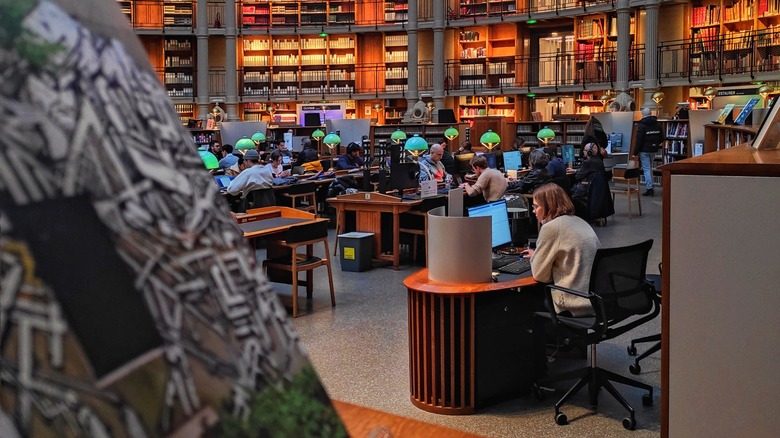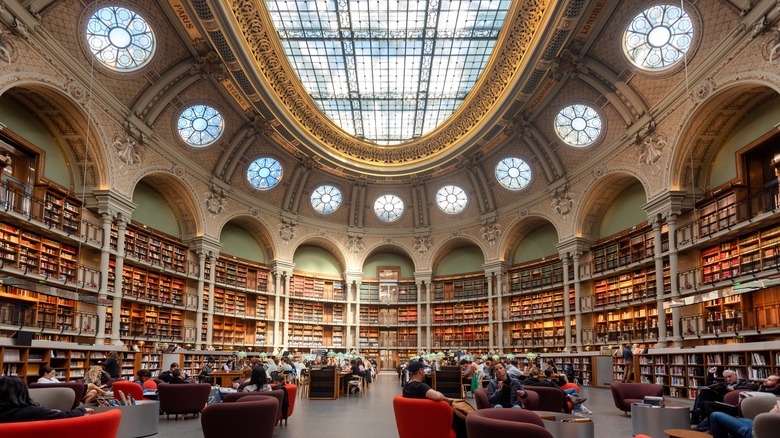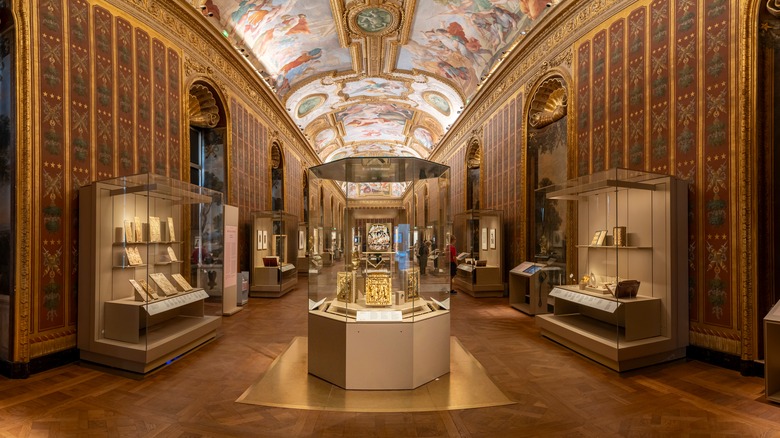One Of The World's Oldest Libraries Is A Giant Spectacular Paris Gem With A Wildly Impressive Collection
If you're a bibliophile who is visiting Paris, the Bibliothèque Nationale de France Richelieu is a stop that's worth your while. Located in the 2nd arrondissement, the Richelieu library — one of the five establishments that collectively make up the Bibliothèque Nationale de France (La BnF) — holds a specific claim to fame. Besides being one of the oldest libraries in the world, it is the historic site where manuscripts, books, and publications have been stored since 1721. For 12 years, the Richelieu location went through extensive renovations before revealing its stunning new look to the public in 2022, just a year past its 300th anniversary.
While tourists flock in droves to the Louvre, the Eiffel Tower, or the Musée d'Orsay, the BnF is a hidden gem that is a less-crowded alternative to these famous landmarks. And, formerly closed off to the public, it is now free of charge to anyone who wants to bask in the presence of books while surrounded by sumptuous architecture and rich historical background, emphasizing why Paris is a top-ranked destination for any visitor, whether you're in a group or solo traveling.
This isn't a normal library — it's a sprawling complex composed of a palace, a hotel, and recent structures, located within proximity of some of the city's most renowned locations — the Palais-Royal, the covered passageway Galerie Vivienne, and the Opera. From the ornate Baroqueness of the Mazarin Galerie to the breathtaking volumes of the free-to-access Oval Room and the newly-opened BnF Museum, the Richelieu site is an under-the-radar destination that must not be missed.
The stunning rooms of the Bibliothéque nationale de France
The Louvre held the first collection of the Royal Library — some 1,200 manuscripts — during the 14th century under the reign of Charles V. Over the centuries, the collection had naturally grown immensely following the law that was put into effect by François I in 1537 that required the library's acquisition of a copy of any French-printed publication. The collection was moved to Fontainebleau in 1544 and stayed there until 1721 when, by the King's order, the library's collection was settled into the western half of the Mazarin palace, now known as the Richelieu site.
By 1857, the modifications to the Mazarin Palace and the annexing of the surrounding structures (the Mansart Gallery and the Tubeuf Hotel) proved insufficient to house the library's ever-growing collection. Architect Henry Labrouste set the groundwork for creating separate areas dedicated to storage, reading, and services, paving the way for a smoother experience for the library's visitors. The Salle Labrouste (Labrouste Room), built in the 1860s, is an architectural masterpiece with nine domes soaring to lofty heights overhead, supported on cast-iron columns. In 1897, work on the Salle Ovale started to accommodate the growing collection, taking 35 years to complete. Here, a canopy of glass panels dominates the ceiling, decorated with gold acanthus leaves and mosaics. Sixteen oculi — circular openings — are spaced evenly below the dome.
Today, anyone is free to spend time reading or studying in the impressive Oval Room, surrounded by the shelves holding a total of 20,000 books — as long as you manage to snag yourself a coveted spot amongst the 160 study seats. Comic books, French history and literature books, and other topical subjects are available for perusal. Internet access and digital mediation booths are also free to access.
In the environs of the Bibliothéque Nationale de France
While you're here, soak in some architecture and history by visiting the new BnF Museum. Displayed across the palatial backdrops of the Column Room, the Louis XV Salon, and the impressive Baroque-style Mazarin Gallery are 900 or so pieces of jewellery, coins, prints, costumes, works on paper, decorative pieces, manuscripts, and more items that comprise the Library's collections. Tickets can be booked online for 10 euros. Entry is free for students and people under 26 years old. Expect to pay more for special exhibitions.
After basking in the architecture and collections, sneak a peek at the BnF's garden, poetically referred to as the "Hortus papyrifer" (paper garden). Here, the carefully curated plant species are connected to themes of paper, print, and writing. Spanning 1,900 square meters, the garden makes for a relaxing and free stroll through a palace in the center of Paris — a truly unique experience for any tourist. Browse the bookshop to take home an official BnF publication on any of the site's collections, open all week except on Mondays. Just like other museum cafés with secret gardens and cozy settings, the BnF's Rose Bakery offers refreshments with indoor and outdoor seating.
The Richelieu site is accessible via the convenient and affordable Paris public transit system, served by the Palais-Royale Musée du Louvre (Line 1), Bourse (Line 3), and Pyramides (Lines 7 and 14). The library is open all week, but check the opening and closing hours of the specific day you are planning to visit on their website, as their schedule varies by day. The BnF museum closes on Mondays. The two entrances are located on 58 Rue de Richelieu and 5 Rue Vivienne, with the former having disabled visitor access.


